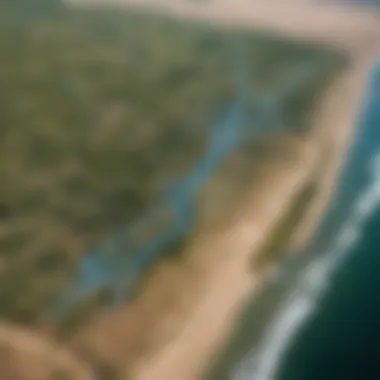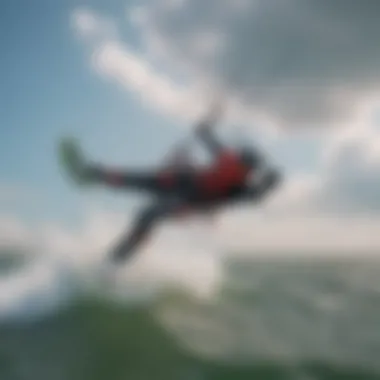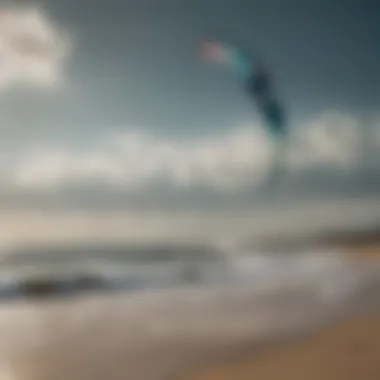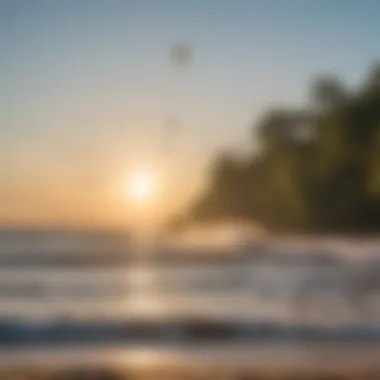Understanding Ohio Wind Direction for Kitesurfing


Intro
Kitesurfing is a sport that heavily relies on wind direction and strength. Understanding how wind works in Ohio can elevate the experience for both beginners and experts alike. This section aims to provide an overview of crucial factors affecting wind patterns in the state, ensuring kitesurfers have a clear roadmap to success on the water. A comprehensive approach will be taken to analyze local wind conditions, geography, and specific spots ideal for kitesurfing.
The Importance of Wind Direction
The direction of the wind is key to kitesurfing. It determines how you ride and the speed at which you can travel. In Ohio, several wind patterns emerge, influenced by geographical features, such as the Great Lakes, flatlands, and hilly terrains. Kitesurfers must be aware of these patterns when planning their sessions.
- Lake Erie: The winds near Lake Erie can offer consistent conditions, often blowing from the west or southwest.
- Flatlands: Areas with minimal obstructions create smoother winds, allowing for better control.
Understanding these variations helps riders choose when and where to launch, ensuring a safer and more enjoyable experience.
Key Factors Influencing Ohio's Wind Patterns
Several elements contribute to the local wind dynamics:
- Geographical Features: The varied landscape of Ohio impacts wind flow significantly.
- Seasonal Changes: Wind patterns shift with the seasons. Cooler months can bring different wind speeds and directions.
- Local Weather: Fronts and storms can change wind conditions rapidly. Riders must stay updated on local forecasts.
"The right knowledge about wind can turn an average kitesurfing day into an exceptional one."
Being informed about local weather systems can often be the difference between a successful session and a frustrating one.
Overview of Equipment for Kitesurfing
Selecting the right equipment is equally as essential as recognizing wind conditions. Kites, boards, and additional accessories play vital roles in achieving an exceptional kitesurfing experience. Though detailed reviews follow, understanding what to look for can guide every rider.
- Kites: Depending on wind speed and riding style, different kites may be more suitable. For instance, larger kites catch more wind but can be harder to control in stronger gusts.
- Boards: Kiteboarding boards vary in design and functionality. Twintips are great for freestyle, while directional boards suit wave riding well.
- Accessories: Harnesses and safety equipment are not just optional; they are vital for ensuring a secure ride.
Ending of Intro
By grasping how to analyze wind direction, factors affecting it, and the equipment needed, kitesurfing enthusiasts can improve their skills and enjoyment in Ohio's dynamic environment. In the sections that follow, more in-depth discussions on equipment reviews, travel destinations, and advanced techniques will enhance this understanding further.
Prelims to Wind and Kitesurfing
Wind is a crucial element in kitesurfing. Kitesurfers rely heavily on the direction and strength of the wind to maneuver effectively across the water. Understanding how wind works is essential for both safety and performance. When planning a kitesurfing session, knowing the wind’s direction can significantly enhance the experience, making it a key consideration for enthusiasts of all levels.
The Importance of Wind in Kitesurfing
Wind is the driving force behind kitesurfing. In this sport, the kite captures the wind, which propels the rider across the water. The direction of the wind influences the type of maneuvers a kitesurfer can perform. For instance, riding with the wind can offer speed and ease, while heading into it might require greater skill and strength. Each wind direction presents unique challenges and opportunities.
In Ohio, the local wind patterns can vary significantly. Understanding these variations allows kitesurfers to plan their outings more effectively. Knowledge of wind speed and conditions can also prevent accidents and improve overall enjoyment on the water. Riders equipped with the right information can maximize their kitesurfing sessions in a variety of conditions.
Overview of Kitesurfing in Ohio
Ohio offers diverse environments for kitesurfing enthusiasts. With access to both Lake Erie and several inland lakes, the state has unique geographical features that contribute to its wind patterns. Kitesurfing has grown in popularity, with many spots attracting locals and visitors.
The kitesurfing community in Ohio is vibrant and active. Riders often share tips on the best locations and optimal wind conditions. Beginners can find abundant resources and support from seasoned kitesurfers. The shared love for the sport fosters a sense of camaraderie that can enhance the overall experience.
In summary, understanding wind direction and its impact on kitesurfing is essential for anyone looking to enjoy this thrilling sport in Ohio. Equipped with the right knowledge, both new and experienced kitesurfers can navigate the local waters with confidence.
Wind Directions: An Overview
Wind direction is a fundamental aspect of kitesurfing, greatly influencing both performance and safety. Understanding wind patterns helps kitesurfers to choose optimal locations and times for riding. This section provides insights into how wind direction operates, emphasizing why it is crucial for enthusiasts.
Understanding Wind Directions
Wind direction is defined by where the wind originates. For instance, a north wind blows from the north toward the south. For kitesurfers in Ohio, knowing the prevailing winds throughout the year can directly impact the riding experience. Different wind directions offer various conditions that can enhance or hinder performance.
Geography also plays a role. The Great Lakes, particularly Lake Erie, create microclimates that can alter wind patterns, making specific areas more favorable for kitesurfing. Understanding these geographic influences allows kitesurfers to make informed choices about where to ride.
Considering all factors, wind direction is non-negotiable for anyone serious about kitesurfing in Ohio.


How Wind Direction Affects Kitesurfing Performance
Wind direction significantly affects the performance of a kitesurfer. The effectiveness of a kite relies on consistent wind coming from favorable directions. Here are some of the key points to consider:
- Lift Generation: Kites work best when wind comes from specific angles. For example, a side-onshore wind generates better lift compared to a directly onshore wind, which could pull the rider onto the beach.
- Control and Maneuverability: The way a kite responds to wind varies with its angle. This variability can affect control, particularly during jumps and turns. Riders must adjust their techniques depending on wind direction to maintain stability.
- Safety Considerations: Unpredictable wind shifts can pose risks. Knowing how to read the wind can help avoid dangerous situations, such as being swept out to deeper waters or crashing due to sudden changes.
Understanding wind direction is as crucial as selecting the right gear. Missing this knowledge can lead to poor performance and increased risks.
In summary, a deep understanding of wind direction enables kitesurfers to adapt their techniques and gear for the best outcomes, ensuring a safer and more enjoyable experience on the water.
Ohio's Geographical Influence on Wind Patterns
Understanding Ohio's geographical influence on wind patterns is essential for kitesurfing enthusiasts. The state's diverse landscape affects wind behavior significantly. Ohio's flat terrains, hilly regions, and water bodies all interact in complex ways, shaping the wind's direction and intensity. This knowledge allows kitesurfers to make informed decisions about when and where to kite, enhancing their overall experience on the water.
Geographic Features and Their Impact on Wind
Lake Erie Influence
Lake Erie plays a crucial role in Ohio's wind dynamics. Being one of the Great Lakes, its vast surface creates distinct weather patterns. It generates steady breezes, especially in summer, which are ideal for kitesurfing. Kitesurfers can take advantage of this consistent wind, making Lake Erie a popular spot for the sport. However, the lake also introduces challenges. The wind can shift suddenly, influenced by local weather changes, which requires kitesurfers to stay vigilant.
Hills and Valleys
Ohio's hills and valleys also impact wind flow. The elevation changes create areas of turbulence, which can affect kitesurfing performance. Coastal regions and nearby hills can enhance wind speeds, making them favorable for advanced riders. In contrast, sheltered valleys may experience reduced wind, posing challenges for those looking for steady conditions. Understanding these geographical nuances helps enthusiasts select the right spots for their skill level.
Urban Areas
Urban areas in Ohio contribute to wind effects through the "urban heat island" phenomenon. Cities can generate localized wind patterns, sometimes leading to stronger breezes. These areas might attract kitesurfers seeking a dynamic environment. However, urban landscapes can introduce obstacles such as buildings and power lines, presenting risks during sessions. Evaluating the safety and wind conditions in urban settings is crucial for kitesurfers.
Seasonal Changes in Wind Patterns
Wind patterns morph with the seasons in Ohio, affecting kitesurfing opportunities. Recognizing these seasonal variations is essential for planning successful outings.
Winter Winds
Winter often brings strong, cold winds to Ohio. While these winds can offer thrilling conditions, they also require specific gear and skills. The chill can deter some kitesurfers, but the brisk winds can be advantageous for those well-prepared with appropriate attire. Understanding how to manage these conditions is vital for safety and enjoyment.
Spring Transitions
Spring is characterized by transitional winds as the weather warms. The combination of shifting temperatures can lead to unpredictable conditions. Kitesurfers must be adaptable, as sudden gusts are common during this time. The key is to monitor forecasts closely and be prepared for varying wind strengths.
Summer Stability
During summer months, Ohio typically enjoys stable and warm winds. These conditions create ideal kitesurfing scenarios, attracting many enthusiasts to the water. The consistent breezes are excellent for all skill levels, making summer a peak season for kitesurfers. Knowing the best times to kitesurf can greatly enhance overall enjoyment and performance on the water.
Autumn Variability
In autumn, wind patterns can become more variable again. The transition to cooler temperatures means sudden gusts and shifts can occur. Kitesurfers should remain alert and flexible, as conditions can change rapidly. This can create both opportunities and challenges. Regularly checking local weather reports becomes essential for safe and enjoyable kitesurfing.
Detailed Ohio Wind Direction Map
Understanding wind patterns is essential for kitesurfing enthusiasts. The Detailed Ohio Wind Direction Map serves as a crucial tool in identifying ideal kitesurfing locations throughout the state. By grasping the nuances of these maps, kitesurfers can optimize their experience, ensuring better performance and safety.
A well-interpreted wind direction map indicates not just where wind comes from but also how strong it is likely to be. This aspect is especially important for those who wish to engage in kitesurfing. Knowing wind speed and direction informs choices about technique, equipment, and even the specific spot along the coast or lake. The wind map allows kitesurfers to plan their sessions based on real-time data.
Interpreting the Wind Direction Map
When you look at the wind direction map, the arrows indicate the source of the wind. For example, if a map shows arrows pointing towards the northeast, this means that the wind originates from that direction. The length of arrows can signify the wind speed—longer arrows usually indicate stronger winds. Understanding these elements can determine if the conditions are favorable for kitesurfing.
It's also important to take note of wind speed categories, as they tell you whether the wind is light, moderate, or strong. Kitesurfers often prefer winds ranging from 12 to 25 mph for optimal performance. Beyond this range, either too strong or too light winds can make the activity less enjoyable or even dangerous.
Key Regions for Kitesurfing in Ohio


In Ohio, certain regions stand out for kitesurfing activities based on their wind conditions and geographical features. Here we discuss three main areas where kitesurfers frequently venture.
Central Ohio
Central Ohio offers a range of lakes that create varied wind conditions. This is significant for kitesurfers wanting to explore different environments. Hoover Reservoir is a notable spot, where the wind patterns can be relatively consistent.
The uniqueness of Central Ohio lies in its combination of open water and nearby land structures that can affect wind flow. While it’s a generally favorable region, potential obstacles, like tall trees or buildings, can cause gusts and shifts in wind direction that may catch kitesurfers off guard.
Northern Ohio
Northern Ohio, with its proximity to Lake Erie, provides strong and steady winds, making it a popular choice for kitesurfing. Locations like East Harbor State Park attract enthusiasts thanks to their favorable conditions. The wind can vary wildly here, but understanding the detailed patterns can help riders decide when to hit the water.
The lake effect also plays a role in enhancing wind speeds, particularly during certain times of year. However, the cold temperatures in the winter season can be a drawback for some.
Southern Ohio
In Southern Ohio, the less popular areas present opportunities for kitesurfing. While the wind conditions might not always be as strong as those found in the northern region, spots like Cowan Lake State Park provide a serene environment for kitesurfing.
The unique feature here is the relatively calm waters, which can be beneficial for beginners looking to hone their skills. However, Southern Ohio is relatively less exposed to prevailing winds, thus making wind direction interpretation even more crucial before attempting to kite.
Proper interpretation of wind direction maps can significantly enhance your kitesurfing experience.
Best Practices for Kitesurfing in Varying Wind Conditions
Kitesurfing offers an exhilarating experience, but it is heavily influenced by wind conditions. Adhering to best practices in varying winds enhances performance and ensures safety. Knowing how to adjust techniques and select appropriate gear is essential for a successful kitesurfing session in Ohio.
Adjusting Techniques Based on Wind Direction
Wind direction plays a significant role in kitesurfing. Each direction presents unique challenges and opportunities.
When facing onshore winds, having a controlled approach is vital. An onshore wind can push surfers toward the shore, requiring precise control of the kite. This may involve maintaining a lower angle of the kite to prevent it from lifting too high, ensuring you stay close to the water surface. Conversely, if the wind comes from offshore, be cautious. It may push you away from the safety of the shore. In this case, you might need to rely more on your board's speed and power to navigate back.
Cross-shore winds can make the riding experience intense. Adjusting your riding stance can help stabilize the kite. Keeping the kite low during jumps is a good tactic as it reduces the likelihood of being lifted too high.
Staying aware of wind fluctuations is key. Use your senses to determine shifts as they can come without warning. Experience is your best guide. Regular practice in different conditions will develop your skills further, allowing you to respond intuitively.
Selecting the Right Gear for Wind Conditions
Choosing suitable gear is crucial for any kitesurfing session. The right equipment matches your skill level and the wind conditions.
- Kite Size and Type:
Wind strength dictates kite size. In high winds, smaller kites offer better control. In lighter winds, larger kites provide more lift. Choosing a kite like the Ozone Edge for strong winds or the Cabrinha Switchblade for versatility can be beneficial. - Board Selection:
The board plays a critical role, too. For challenging conditions, a smaller board may be necessary to handle gusty winds. In contrast, a larger board works well during light wind sessions, offering more surface area to catch the breeze. - Bar Setup:
Adjusting the bar length can influence steering response. Short bars can be more responsive in strong winds, while longer ones can help in light conditions. - Safety Gear:
Never underestimate the importance of safety gear. Helmets, impact vests, and harness releases contribute to safer riding.
In summary, selecting the appropriate gear not only enhances performance but also protects you across various wind conditions. Revisit equipment choices often to make adjustments based on experience and changing conditions.
"Understanding the interplay between wind direction, kite type, and riding posture can transform your experience on the water."
Following best practices in varying wind conditions equips you to face challenges with confidence. By adjusting techniques and selecting the right gear, Ohio kitesurfers can enjoy a safer and more thrilling ride.
Safety Considerations with Wind Direction
Safety is a core element of kitesurfing, especially regarding wind direction. Neglecting safety can lead to serious accidents and injuries. Understanding wind behavior and its warnings can greatly improve the overall experience on the water. It’s crucial for kitesurfing enthusiasts to be aware of weather conditions before launching. The right precautions can create a safer environment for everyone.
Understanding Wind Warnings and Alerts
Wind warnings and alerts play a vital role in ensuring kitesurfers are informed about potentially hazardous situations. Local weather systems often issue alerts based on wind speed and direction. For instance, a sudden increase in wind speed can create difficult currents or chop, thereby increasing the risk of losing control over the kite.
Key Points on Wind Alerts:
- Types of Alerts: Recognizing different types of weather alerts is crucial. There may be advisories, watches, or warnings depending on the severity of the wind conditions.
- Localized Weather: Sometimes, weather changes can occur suddenly, particularly near large bodies of water like Lake Erie. Local knowledge from seasoned kitesurfers may also provide insight on how to interpret these changes based on their experience.
- Monitoring Tools: Utilizing weather apps or websites specializing in wind forecasts can help kitesurfers stay updated.
Risk Management in Kitesurfing


Risk management is essential for safer kitesurfing practices. It involves assessing the conditions and preparing for unexpected developments.
Assessing Conditions
Evaluating conditions before heading out can immensely increase safety. This includes checking wind speeds, possible changes in weather, and the current water state. Knowing if it’s too gusty or if the winds are unpredictable becomes essential.
Key Characteristics of Assessment:
- Wind Speed Monitoring: Regularly check the speed to understand if it aligns with your skill level. Beginners should avoid high winds.
- Local Conditions: Understanding local factors, such as how terrain affects wind flow, can be advantageous. Detours around hills or buildings can lead to sudden wind shifts.
The primary advantage of assessing conditions is informed decision-making. This can ensure that kitesurfers are energized for an optimal ride or know when it’s prudent to stay on land. However, the downside remains in the unpredictability of sudden weather changes, necessitating quick judgment.
Emergency Procedures
Emergency procedures are crucial for kitesurfers, especially when faced with sudden challenges. Knowing what to do in an emergency can be lifesaving. Training and preparedness are essential touchpoints in this process.
Key Aspects of Emergency Procedures:
- Clear Protocols: Establishing specific protocols for various emergencies, such as losing control of the kite or sudden shifts in wind, can help remain calm and focused during crises.
- Rescue Techniques: Familiarity with self-rescue techniques can be a game-changer. This knowledge can only enhance safety; it can also minimize potential injury.
Emergency procedures' unique feature lies in their adaptability. Each kitesurfer may need different approaches based on experience and skill level. Being equipped with safety gear like a quick-release harness or floatation device can help minimize negatives during an emergency.
Staying informed and prepared increases safety for everyone involved in kitesurfing.
Local Insights and Community Advice
Learning from Experienced Kitesurfers
The value of gaining insights from seasoned kitesurfers cannot be overstated. These individuals have personal experiences that can enhance the learning curve for newcomers. They know the specific challenges related to various wind conditions in Ohio and can provide practical tips.
For example, understanding how local topography affects wind can lead to better decision-making on when and where to kite. Experienced kitesurfers often share real-time information about how particular areas behave under different wind conditions, offering a real-world context that is more beneficial than textbook knowledge.
Networking with these skilled athletes can also result in shared resources and access to lesser-known spots that are ideal for kitesurfing.
Key takeaways include:
- Personal anecdotes that detail successes and failures on the water.
- Recommendations for gear suited to Ohio’s specific wind patterns.
- The best times of the year or day for optimal wind conditions.
Building a Kitesurfing Community in Ohio
Creating a kitesurfing community in Ohio is essential for fostering both camaraderie and collective learning. A supportive network can greatly enhance the kitesurfing experience, allowing enthusiasts to share insights, organize events, and tackle challenges together.
Local meet-ups and group sessions can facilitate friendships while encouraging skill-sharing among kitesurfers of all levels. Online platforms such as Facebook groups and Reddit forums can also help maintain connections. They offer spaces to ask questions, exchange tips, and showcase achievements.
Some considerations for building this community include:
- Organizing local kitesurfing events such as competitions or casual meet-ups.
- Creating an online forum or social media group to share experiences and advice.
- Encouraging inclusivity so beginners feel welcomed and supported.
By engaging with one another, kitesurfers can gain a wealth of knowledge, ultimately making for a stronger and more informed community.
"In kitesurfing, as in many sports, your growth often depends on those around you. Building a community can create a better environment for all."
Understanding the significant role local insights play in Ohio’s kitesurfing scene can enrich the activity for everyone involved.
Finale
In understanding the wind direction in Ohio, kitesurfers gain valuable insights that can significantly enhance their experience on the water. This section encapsulates key takeaways and discusses the implications for future kitesurfing activities in the state.
Recap of Key Points
The article highlights several vital aspects of wind dynamics specific to Ohio. Key points include:
- Role of Wind in Kitesurfing: Wind direction and speed are crucial for optimal performance; knowing how wind behaves in this region is essential.
- Geographical Influences: The proximity to Lake Erie, diverse terrain, and urban development all shape local wind patterns.
- Seasonal Trends: Wind conditions vary significantly with the passage of seasons, impacting the best times for kitesurfing.
- Safety Considerations: Understanding wind warnings and being prepared for sudden changes is mandatory for safe kitesurfing.
- Community Insights: Learning from the experiences of other kitesurfers in Ohio provides perspective on best practices and local conditions.
Future of Wind Patterns in Ohio
The examination of Ohio’s wind directions does not conclude with current insights. Future implications of changing weather patterns must be considered. Climate change may bring about new challenges in understanding local winds. In particular, shifting weather systems could lead to unpredictable wind behavior. Kitesurfers should stay informed and adaptable. Regular updates on weather forecasts and continued community dialogue will be crucial. Furthermore, research into Ohio's evolving topography can offer additional understandings of its impact on wind patterns.
Overall, staying attuned to both established patterns and emerging trends will empower kitesurfers to make informed decisions. This ongoing awareness plays a novel role in ensuring memorable and exhilarating rides throughout Ohio.







